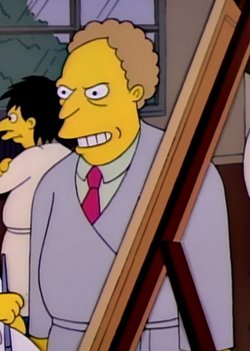
Difference between revisions of "Mr. Schindler"
Wikisimpsons - The Simpsons Wiki
m (Bot: Replacing category One time characters with One-time characters) |
m (→Behind the Laughter: replaced: {{w| → {{W|) |
||
| Line 18: | Line 18: | ||
== Behind the Laughter == | == Behind the Laughter == | ||
| − | Mr. Schindler praised a painting of {{ | + | Mr. Schindler praised a painting of {{W|Emmett Kelly}}'s sad clown figure "Weary Willie", which was based on the hobos of the Great Depression. |
== Appearances == | == Appearances == | ||
Latest revision as of 21:46, October 15, 2021
Mr. Schindler
| ||||||||||
Character Information
|
Mr. Schindler was the art teacher at Springfield High School during the time when Marge Simpson was a student there.
History[edit]
Mr. Schindler disliked Ringo Starr and was tired of Marge painting portraits of him. In one occasion, he dumped a canvas Marge had just finished and praised another student's painting.
Behind the Laughter[edit]
Mr. Schindler praised a painting of Emmett Kelly's sad clown figure "Weary Willie", which was based on the hobos of the Great Depression.
Appearances[edit]
Springfield High School
| ||
|---|---|---|
| Faculty | ||
| Mrs. Bloomenstein • Franklin Chase • Harlan Dondelinger • Coach Flanagan • Mr. McIntyre • Mr. Orlando • Mr. Schindler • Mr. Seckofsky | ||
| Former students | ||
| Marge Bouvier • Carl Carlson • Vance Connor • Estelle • Barney Gumble • Julius Hibbert • Kim • Lenny Leonard • Helen Lovejoy • Bobby Mindix • Evelyn Peters • Debbie Pinson • Clarise Rashad • Sasha Reed • Sandra • Homer Simpson • Waylon Smithers • Chloe Talbot • Kirk Van Houten • Artie Ziff | ||
| Present students | ||
| Jake Brickbat • Shauna Chalmers • Johnny Joe • Trevor McBride • Montaigne Prince • Squeaky-voiced teen | ||
| Future students | ||
| Wendell Borton • Lewis Clark • Jenda • Sherri Mackleberry • Terri Mackleberry • Nelson Muntz • Janey Powell • Martin Prince • Richard • Becky Shorter • Bart Simpson • Lisa Simpson • Allison Taylor • Milhouse Van Houten • Ralph Wiggum • Üter Zörker | ||
| Other | ||
| Butthead |
The Simpsons characters
| ||||||||||||||||||||||||||||||||||||||||||||||||||||||
|---|---|---|---|---|---|---|---|---|---|---|---|---|---|---|---|---|---|---|---|---|---|---|---|---|---|---|---|---|---|---|---|---|---|---|---|---|---|---|---|---|---|---|---|---|---|---|---|---|---|---|---|---|---|---|
| ||||||||||||||||||||||||||||||||||||||||||||||||||||||

